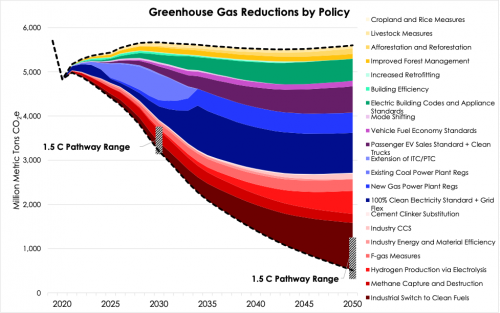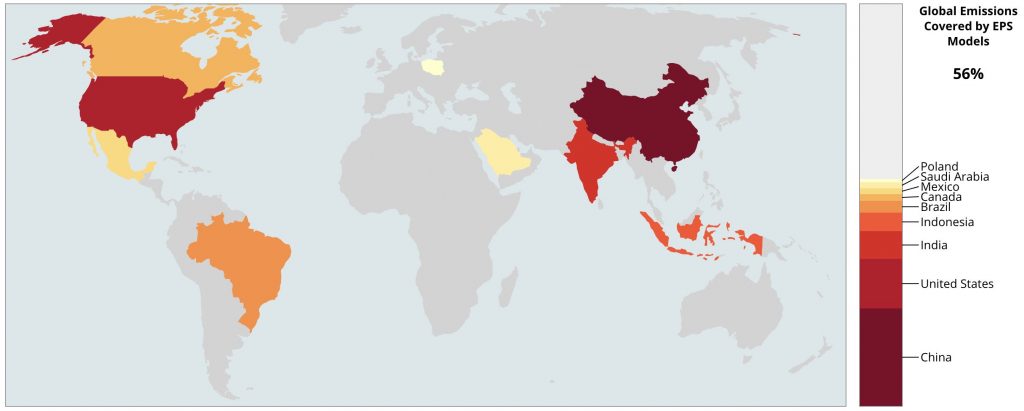Energy Policy Solutions
The Modeling and Analysis Program delivers quantitative policy insights and detailed policy design guidance directly to policymakers, regulators, and other stakeholders. This includes developing our in-house model, the Energy Policy Simulator, and propagating policy design insights from our book Designing Climate Solutions. These tools assess potential emissions mitigation, economic impacts, job creation, and health benefits of different policies to offer advice to policymakers.
Trillions are spent every year dollars generating and consuming energy across the globe, with much of it landing on investments that fuel the climate crisis. Most energy infrastructure is built to last for decades, which makes it crucial to get energy policy right. Well-designed and well-implemented energy policy can improve energy security and rapidly reduce emissions while growing the economy and creating jobs. Done wrong, energy policy can waste billions and lock in dirty, inefficient systems for decades to come.
Our Work
Energy Innovation’s Modeling and Analysis Program answers two key questions:
- Which policies will most meaningfully reduce emissions, and how stringently must they be set to achieve necessary climate goals?
- How should these policies be designed and implemented to maximize their beneficial interactions, ensure compliance, and avoid unintended consequences?
We address the first question through our open-source, peer-reviewed Energy Policy Simulator which uses government data to estimate the environmental, economic, and human health impacts of hundreds of climate and energy policies.
Energy Innovation has partnered with international organizations and government agencies to develop EPS models for many of the world’s largest emitters including China, the United States, India, Indonesia, Canada, and Mexico; EPS models have also been developed for multiple subnational regions across China, the U.S., and Canada. Combined, these models cover more than half of total global emissions.
The EPS identifies policies capable of securing deep decarbonization and recommends the most effective policies for each country or subnational region while evaluating the economic, emissions, and public health impacts of those policies. It provides much more flexibility than other models in modeling policy options and can do so much faster, and while accounting correctly for policy interactions
The EPS model is accessible under the GPL v3 license. Users are free to download, distribute, transform, and modify the EPS as long as they indicate if changes were made and make modified versions publicly available under the GPL v3 license.
EPS model results may be published under the CC BY 4.0 license, which requires attribution to Energy Innovation Policy & Technology LLC®. Users are free to run their own scenarios and generate insights and findings. Energy Innovation Policy & Technology LLC® does not endorse modeling created by users unless explicitly stated, and users are responsible for their own results produced using the EPS.
 Domestic examples include exploring how emissions would decline if the U.S. adopted the top climate and energy policies currently enacted in other countries, modeling the House Select Committee on the Climate Crisis’ Action Plan, and identifying the policy pathway capable of reaching a 1.5 degree Celsius Nationally Determined Contribution to the Paris Agreement.
Domestic examples include exploring how emissions would decline if the U.S. adopted the top climate and energy policies currently enacted in other countries, modeling the House Select Committee on the Climate Crisis’ Action Plan, and identifying the policy pathway capable of reaching a 1.5 degree Celsius Nationally Determined Contribution to the Paris Agreement.
Global examples include identifying policy gaps for achieving China’s climate targets in the Paris Agreement and policies to help it save billions while peaking emissions by 2030, policies that would enable Mexico to achieve its emissions targets, and policies that would empower Canada to reach its commitment to the Paris Agreement.
We address the second question in our policy design book: Designing Climate Solutions: A Policy Guide for Low-Carbon Energy. Designing Climate Solutions is the first comprehensive guide outlining which well-designed and implemented energy policies can put us on the path to a low-carbon future. The book explains best practices and principles for each of these top policies and includes case studies from around the world. Most of the book’s content is free to read online via its complementary website.

